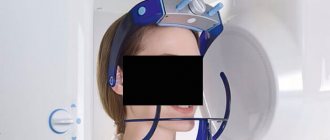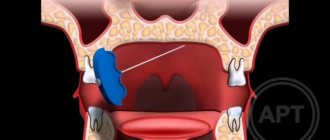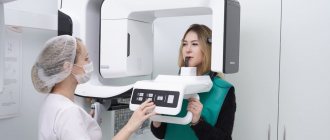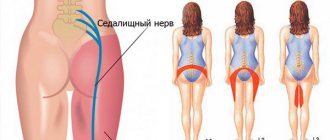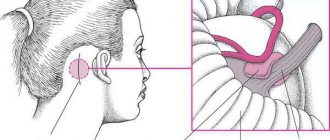Inflammation of the facial nerve is an unpleasant ailment that does not go away painlessly. The main complaints of patients are sharp attacks of pain in the face, in the upper and lower jaws.
This inflammation is considered one of the most common among facial pains. Most often, the disease proceeds without a trace, but if treatment is neglected, paralysis may occur.
The disease most often occurs in women over 50 years of age; men are treated with this disease much less frequently. People with a genetic predisposition, such as a narrow bone canal, are also at risk. Due to this anatomical feature, there is an increased risk of pinching due to impaired blood supply and various inflammations.
What is the facial nerve?
The trigeminal nerve, also known as the facial nerve, is the largest of the twelve cranial nerves. It originates in the ear, after which it branches, the first path reaches the frontal part, the second is located at the jaw. The nerve goes around almost the entire surface of the human face; it literally controls it.
Every person has two facial nerves - one on each side of the head. It is in contact with other cranial nerves and has supersensitive fibers.
Doctors divide the disease into two types - primary and secondary. The primary one manifests itself as a complication from a cold, in this case the normal nutrition of the nerve is disrupted. Secondary occurs with severe intoxication against the background of inflammatory or infectious diseases, as well as tumor processes.
Myths and dangerous misconceptions in treatment
Due to the fact that neuralgia does not affect the general condition of the body, many patients postpone visiting a doctor and treating the trigeminal nerve. In fact, this is the wrong approach, since the disease can lead to paralysis and muscle paresis. In addition, it has a significant impact on psychological and social aspects of life.
No less important is the fact that painkillers for trigeminal neuralgia provide only a temporary effect. Over time, anticonvulsant medications may also stop working as they become addictive. Therefore, you should not abuse medications. They only relieve the symptoms of neuralgia, and its cause can only be identified by a qualified specialist.
Causes of inflammation of the trigeminal nerve on the face
Usually the disease is caused by infection or bacteria. List of reasons why inflammation of the facial nerve may occur:
- Temporomandibular joint injuries
- Tumors (benign and malignant) of the brain and facial area
- Anomalies of skull development
- Skull injuries - birth, fracture, base, damage to the face or jaw
- Polio
- Pulmonary tuberculosis
- Otitis
- Sinusitis
- Chronic caries
- Inflammation after tooth extraction or treatment
- Hypertension
- HIV and AIDS
- Poisoning
- Inflammation of the middle ear
- Severe hypothermia of the head
- Changes in hormonal levels in women
- Gum inflammation
- Ramsay Hunt syndrome
- Stroke
- Bell's palsy
Causes range from minor to life-threatening illnesses. Each of the reasons determines the further treatment of the patient. In some cases, special tests are performed for diagnosis - auditory, lacrimal, infectious, salivary or gustatory. In this way, the functioning of the receptors and sensory organs is checked.
Symptoms of inflammation of the trigeminal nerve
Experts include short-term, but acute and intense pain in different parts of the head as the main symptoms of facial neuralgia. Shooting attacks spread over the entire surface of the face - lips, eyes, nose, upper and lower jaw, gums and tongue.
Patients also report the following symptoms:
- Metallic taste in the mouth
- Muscle weakness
- 2-3 days before facial expressions are affected, pain occurs behind the outer ear, spreading to the face, back of the head and eyes
- Facial asymmetry
- Inability to close the eye on the affected side
- Drooping corner of the mouth
- Dry mouth
- Slurred speech
- Cross-eyed strabismus
- Uncontrollable tearing
- Disorders of taste buds
- Increased drooling
- Facial muscle spasms
- Increased or decreased facial sensitivity
- Temperature increase
Due to discomfort and pain, the patient begins to develop a phobia and increased anxiety. He tries to avoid poses and movements that provoke discomfort.
Surgical operation to remove a tooth
Removing the top 8s is usually faster and more painless than removing the bottom 8s. This is due to the fact that the bone tissue of the lower jaw is more dense, and the root system is more branched. The tooth extraction operation itself is painless as it is performed under anesthesia.
A simple removal procedure usually lasts no more than 10 minutes. In this case, there is no need to cut the gum or saw the tooth. It is removed from the hole using forceps. A special drug is placed in the hole to prevent the development of inflammation. In most cases, gum suturing is not required.
Make an appointment
For complex wisdom teeth removal, the following techniques are used:
- cutting the gums;
- drilling of bone tissue;
- sawing the tooth and extracting it into fragments;
- suturing the mucosal defect.
To prevent complications after removing the figure eight, the hole is washed with an antiseptic solution and a special drug is placed in it, which has an antibacterial and anti-inflammatory effect. After this, the wound is sutured.
Diagnosis of inflammation of the trigeminal nerve
Depending on the affected area and the set of symptoms, the strategy for diagnosing the disease is determined. To determine the location of nerve damage, the severity and dynamics of recovery, doctors prescribe a hardware diagnostic method, for example, electromyography. MRI and CT scans are used to determine the presence of tumors in the brain.
The patient may also be referred for a general or biochemical blood test, x-ray of the lungs, ultrasound of soft tissues or ophthalmoscopy.
You can be confident in the quality of the procedures performed in the clinic and the high accuracy of the results of MRI, CT and other methods of diagnosing various diseases. Medunion performs magnetic resonance imaging of all types: head, spine, abdominal cavity and joints using modern equipment.
Prices for wisdom tooth removal
| Primary appointment (examination, consultation) with a dentist | 500 rub. |
| Appointment (examination, consultation) with a dentist using a CT scan and drawing up a treatment plan | 1,000 rub. |
| The operation of removing impacted (semi-retained), dystopic 8th tooth with root separation | 7,500 rub. |
| The operation of removing impacted (semi-retained), dystopic 8th tooth with cutting out a mucoperiosteal flap and partial resection of the cortical plate of the bone | 10,000 rub. |
Treatment for inflammation of the facial nerve
Drug treatment
Treatment of trigeminal neuritis is complex. The disease is first treated with medication - the patient is prescribed drugs that will alleviate the situation. These include painkillers, decongestants, vasodilators and B vitamins. Most often, the recommended medications are tablets, but you can speed up the recovery process by using ointments and gels. Sometimes doctors prescribe intramuscular injections.
In special cases, the recovery process of the facial nerve may be slowed down. Then the patient is prescribed glucocorticosteroids, which improve the metabolic processes of nervous tissue. Various biostimulants and hyaluronidases also contribute to a speedy recovery.
You cannot prescribe medications for yourself. Be sure to see a neurologist or neuropathologist at the first symptoms to determine the diagnosis and treatment strategy. Recovery medications are recommended to patients on a case-by-case basis, paying attention to the presence of chronic diseases, symptoms, and so on.
Surgery
Another way to treat the facial nerve is surgery. However, doctors turn to this option quite rarely - only when the trigeminal nerve is ruptured. Surgery is also required if there is no effect from the conservative method after six months or a year. Surgical intervention is only relevant during the first year of the presence of the disease; later, the muscles on the face irreversibly atrophy.
The surgical process involves suturing the damaged area of the facial nerve to restore its motor function.
Massage
The next treatment method is massage for the treatment of the facial nerve. The purpose of this method is to remove swelling, improve blood circulation, restore sensitivity and conduction of nerve impulses. Massage is contraindicated for tuberculosis, oncology, atherosclerosis and elevated temperature.
Initially, the massage therapist works only with the healthy side of the face, collar area, neck and area above the shoulders. Basically, the master uses rubbing, stroking, kneading and vibration.
For noticeable desired changes, it is necessary to conduct ten to twenty massage sessions from five to fifteen minutes. The duration is determined based on the degree of inflammation of the trigeminal nerve, the goals of therapy and the dynamics of recovery.
Physiotherapy
The next treatment method is physical therapy. It alleviates the severity of symptoms, helps to activate metabolic processes in tissues and restore the functions of the facial nerve.
Doctors prescribe this course of treatment from the first days of the onset of neuritis. The list of physical procedures includes:
- Ultrasound
- Laser irradiation of blood
- Electrophoresis of drugs
- Microwave therapy
- Exposure to ultra-high frequency electricity
- Ozocerite treatment
- Myoelectrostimulation
- Darsonvalization
This complex is indicated for the first week of treatment. Doctors prescribe it together with medication. This tandem helps speed up the process of restoration of the facial nerve. And its most important advantages are the absence of side effects and painlessness.
Alternative Methods
There are also alternative treatment methods. These are procedures aimed at restoring facial muscles and eliminating the symptoms of facial neuritis. Such procedures include:
- Clay or paraffin masks
- Acupuncture
- Reflexology
- Injections to eliminate muscle disorders
- Therapeutic baths
- Taping – stretching the face using adhesive plasters
- Immunosorption – purification of blood from antigens and antibodies
- Biofeedback – facial muscle training
Gymnastics for the face
Also, in conjunction with complex treatment, you can do facial exercises. Before this, you need to consult with a specialist; the doctor will draw up an individual list of exercises based on the severity of the process, location of the lesion and symptoms. Typically, such gymnastics takes about ten minutes a day.
A standard set of exercises includes relaxing and tensing individual facial muscles. For example, to restore articulation, it is recommended to pronounce the sounds “u”, “o”, “and”. Afterwards, you need to bring your lower lip under your upper teeth and reproduce the sounds “v” and “a”.
Gymnastics for inflammation of the trigeminal nerve:
- Close eyes
- Raise your eyebrows
- Frown
- Squint
- Smile with your mouth closed
- Smile with your mouth open
- Puff up your cheeks
- Pull them back
- Whistle
- Widen your nostrils
- Curl your lips
- Raise your upper lip and return to the starting position
- Lower your lower lip and return to the starting position
- Take water into your mouth
- Rinse your mouth
- Close your mouth
- Run the tip of your tongue along your gums
- Move your tongue right and left
RECOMMENDATIONS OF EXPERTS
We recommend that you strictly follow all your doctor’s instructions and do not self-medicate - the tooth socket will heal quickly and will not cause pain.
General rules that must be followed after wisdom tooth removal:
- Avoid eating and drinking hot drinks for 2 hours.
- Drinking alcohol is strictly prohibited.
- Avoid smoking for 2 hours (nicotine interferes with blood clot formation).
- All kinds of heating are strictly prohibited - it is fraught with purulent inflammation.
- Upon arrival home, you need to apply ice wrapped in cloth on the side of the cheek of the extracted tooth according to the following scheme: 5 minutes cold - 10 minutes rest, repeat the cycle several times during the day. Cold constricts blood vessels, so the risk of bleeding, hematoma formation and swelling is significantly reduced; The procedure helps reduce pain.
- For several days after surgery, physical activity, as well as visiting a bathhouse or sauna, are contraindicated. Violation of these recommendations may cause bleeding.
- Rinsing is prohibited - it will lead to the loss of a blood clot, which significantly aggravates the healing process of the tooth socket.
Prescribing and taking antimicrobial and anti-inflammatory drugs only as prescribed by your doctor individually!
Disease prevention
Doctors recommend eliminating effects on the body that cause inflammation of the trigeminal nerve. Here are some recommendations to help avoid illness:
- Avoid drafts and hypothermia
- Keep your head warm during the cold season
- Monitor your blood pressure
- Timely treatment of infectious and bacterial diseases
- Have a routine check-up with an oncologist
- Avoid skull and head injuries
You can sign up for an individual consultation, take tests or undergo treatment at the Medunion private clinic. You can easily make an appointment with us by calling 202-95-54 or online, directly on the website, by clicking on the “Online booking” button.
We have been working in Krasnoyarsk since 2006 and provide high-quality medical services to the population. The staff consists of highly qualified doctors of broad and narrow specialization.
When to see a doctor
If you experience symptoms of trigeminal neuralgia, you should immediately consult a doctor, as it may be a sign of another serious disease. In the treatment of neurological pathologies, accurate and timely diagnosis is extremely important. This is done by a neurologist, with whom you can make an appointment at our clinic in the center of Moscow. The specialist knows not only how to relieve trigeminal neuralgia, but also how to correctly diagnose it in order to prescribe effective treatment in the future.
